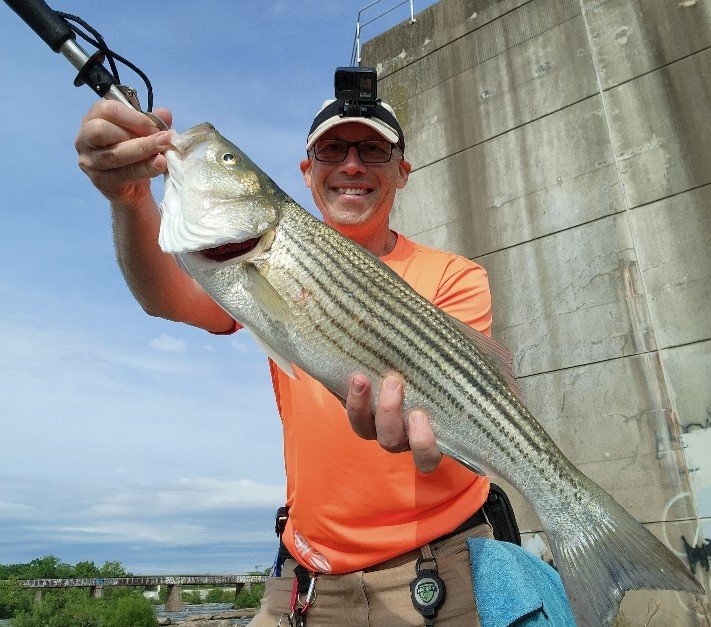So, you want to catch a striped bass? Me too!
By Ron Binshtok
I'm a largemouth bass fisherman, but not that long ago I found something new to love about the James River: the spring striped bass migration.
As the water temperature approaches 50 degrees, striped bass make their way up from the ocean to spawn, showing up in the river in big numbers. Also arriving to the river in numbers are the anglers, all wanting to catch a striped bass. But maybe you're like I was in the beginning and don't know where to start. That's why I'm writing this post. I want to share my experience both good and bad in hopes that I can make your quest to target these fish less painful, or better yet, more enjoyable.
Getting started.
For me, I jumped in feet first...using my existing largemouth gear, most of which was bait casting setups in the 6.5ft to 7ft range. I used spinnerbaits, lipless crankbaits, and small topwater plugs, most of which I already had. I wasn't familiar with striper fishing setups, so I defaulted to what I (thought) I knew. I learned quickly that my gear underperformed for the fishing style needed. My bait casters were horrible with all the bird-nesting issues I encountered "trying" to sling lures far out into more open water. I couldn't achieve the casting distances needed to target fish in deeper channels from the bank. I tried to compensate by using my 7ft spinning setup, but that got me only so far. I did eventually get lucky and connect with a few stripey fish, but my challenges continued as I struggled to fight and successfully land them. That struggle persisted as my fishing line/leader was too weak and fish would break off either from their intense fighting or the braid would rub against rock and wood, abrading and snapping the line. The James River is notorious for its profusion of debris and structure, often leading to snagged lures. Nine times out of 10, I would break the line trying to free up a snagged lure. Losing several expensive lures adds up quickly and ends with much frustration.
So what did I do with all of this?
I made a conscious effort to watch, listen, and learn from local anglers. From rods to reels to lures, I focused my attention on what experienced fishermen were using. I absorbed details around how the tide, water temperature, and weather conditions affected the movement and feeding patterns of these fish. Knowing what areas of the river attract and hold fish under various river conditions improved my chances of landing these beautiful fish. Much of this information was shared via on-the-job training.
Nothing's better than standing at the water's edge and identifying critical features important to fish movement. For example, under certain tidal or flow conditions, one might find slack water in a particular area. However, under other conditions, that same area might reveal a rock or cluster of debris that juts above the waterline creating eddy currents. Understanding the anatomy of the river and how fish respond to water levels, tides, and time of day can be the difference between casting practice and hauling in multiple fish. I became friends with these river experts, which is not hard to do when you cross paths with them each time you venture out. These friends let me try out their setups to get a feel for what differences exist with my tackle compared to their legit setups better suited for targeting striped bass.
After weeks (months) of observing, researching, and talking to many experienced anglers, along with waiting for tackle inventory to replenish after the season, I invested in two new setups. Both were larger 8ft and 9ft surf rods with beefed-up saltwater-rated spinning reels. These combos were larger than anything I'd owned previously. I was now able to use a higher pound-test (30 to 50lb braid) and heavier leaders (40-50lb fluorocarbon), which made an enormous difference in every aspect of catching these fish.
Now I had my chance to really learn new techniques...from how to tie an FG knot with heavy line (awesome knot, look it up!) to how to throw multi-ounce pencil poppers and large plastic swimbaits. One of the biggest game changers was learning how to successfully free up snagged lures, a rare possibility with a medium-power, 6ft setup. Having a longer rod with a significant backbone, along with an appropriate line/leader, allowed me to finally learn how to break loose lures from all kinds of structure without having to be "gentle". Now I could try what others would call the "banjo" method to unstick lures. I learned this technique from a friend in real-time, as it's nuanced and hard to accurately describe. Essentially, I'd load up the rod under extreme pressure with one hand while simultaneously stretching the line above the reel further away from the rod with the other hand. The line is abruptly released—while keeping pressure on the rod—sending a shockwave down the line toward the snagged lure. Ideally, the snagged hook is dislodged and with it brings a smile of accomplishment to the face of those who have mastered the technique. Join me on the water sometime, and I'll show you how to do it!
So, you still want to catch a striper?
I hope my (limited) experience will help inform and inspire you to catch your own. With a bit of knowledge, connecting with some good people, and having the right setup, you are well on your way to successfully landing these beautiful fish! Just remember to gently release them with care so I can catch 'em next time.
Want to connect? I’m happy to share more details on lure/tackle selection and fishing locations!
Stop by my Instagram & check out my YouTube channel for some of my fishing fun…especially those striper fishing videos!
Until next time, tight lines!
Ron Binshtok




